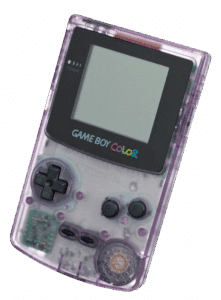
The Game Boy Color (GBC) is a fifth-generation handheld video game console developed and manufactured by Nintendo. It was released in 1998 as the successor to the original Game Boy, featuring a color screen and increased processing power.
Key features
- Color Display: The GBC’s main innovation was its color screen, a significant upgrade from the monochrome display of its predecessors. The screen was a reflective thin-film transistor (TFT) LCD, capable of displaying up to 56 simultaneous colors from a palette of 32,768.
- Faster Processor and More Memory: The console featured an 8-bit processor that was roughly twice as fast as the original Game Boy’s, along with four times the system memory (32 KB RAM).
- Backward Compatibility: One of the most praised features was its backward compatibility, which allowed it to play most Game Boy cartridges. When playing older monochrome games, users could choose from a selection of twelve color palettes to add limited color to the experience.
- Infrared Port: An infrared communications port was included, enabling wireless data transfer and multiplayer for a small number of games. This feature was dropped in later Game Boy models.
- Multiple Cartridge Types: To manage compatibility, three distinct cartridge types were used:
- Gray Cartridges: Standard Game Boy games that used default color palettes on the GBC.
- Black Cartridges: Enhanced games that could use the full color range on a GBC but were still backward-compatible with older Game Boy models.
- Clear Cartridges: Games designed exclusively for the Game Boy Color, which were not playable on earlier models.
Game library and commercial success
The Game Boy Color’s launch and eventual market success were heavily influenced by the popularity of the Pokémon franchise.
- Best-selling titles: The best-selling games developed specifically for the GBC were Pokémon Gold and Silver, which shipped over 23 million units. The best-selling exclusive was Pokémon Crystal.
- Strong third-party support: The console attracted a wider range of third-party developers, producing hit games like Dragon Warrior Monsters and Metal Gear Solid.
- Sales: The GBC, along with the original Game Boy, sold a combined total of over 118 million units worldwide.
Legacy
- Short lifespan: Despite its success, the GBC had a relatively brief time in the market, being succeeded just under three years later by the more powerful Game Boy Advance (GBA). The GBA was also backward-compatible with both Game Boy and Game Boy Color games.
- Key innovation: The Game Boy Color marked the end of the monochrome handheld era for Nintendo and set a new standard for portable gaming with its color screen.